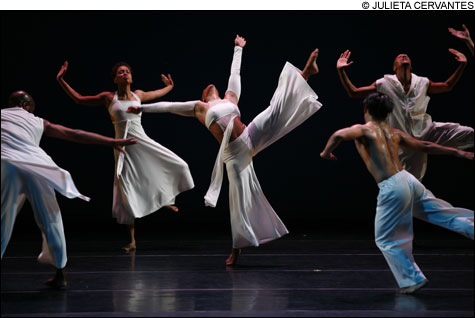
GRACE Good versus evil, and bands of angels coming to the rescue. |
Ronald K. Brown’s flamboyant choreography comes with a big serving of spirituality. The combination isn’t as contradictory as you might think — mainly because pious invocations and gestures only slip in and out of the dance itself, leaving the program notes to carry the story lines of an upward-striving journey.
The three dances on the bill last weekend — when CRASHarts brought Brown’s company, Evidence, to the ICA — centered on ideas of black history and community as well as religious faith. Early in the evening I gave up trying to track Brown’s message, but I thought his way of making movement was absorbing in itself.
With characters and behaviors that could tie abstraction to everyday life, all three dances took the same approach, though they had different themes. In the most recent, Two-Year-Old Gentlemen, five men in street clothes assembled thoughtfully or with brotherly embraces. Then they opened out into much longer episodes of dancing, to recorded gospel songs and West African drumming.
Prayerful moves sent them into swooping, outflung turns, jumping and traveling leaps in groupings and solo variations. Their seemingly non-stop rhythmic movement was derived from sources in African and modern dance that were blended with the kicks and punches of capoeira and the pops and stomps of hip-hop. Sometimes the men alternated between dancing for one another in circles and dancing in inward-facing lines; sometimes they abandoned their solidarity to come straight at the audience with a display of show-biz extroversion.
In the longer stretches of dancing, to the accompaniment of the fantastic Guinean drummer Mohammed Camara, they went from one phrase to another in a constant stream of invention instead of keeping up a repeating rhythmic step pattern, as you’d see in a lot of African tribal dancing. This had the oddest effect on me. At first I thought the dancers were working against the drumming, or ignoring its insistent propulsiveness. But then I realized they were picking up on Camara’s equally inventive inner rhythms. Their visualization of these intricate beats brought out the changing dynamics of the sound and played down its persistent regular pulse. Too bad the company didn’t bring Camara to play on stage for these performances.
I also noticed, throughout the program, that the dancers seemed soft and calm in contrast to the explosive energy or the shouts and stratospheric vocalizing of the drummers and singers who accompanied them.
Incidents (1998) featured a solitary Tiffany Quinn walking and making huge, agitated leaps and lunges as she circled the stage. Two other women stood over a third, who knelt facing upstage. For a long time, they seemed to be sponging her back, with soothing, healing hands. The program spoke of an escaped slave, but this was the dance’s only hint of that story. Later on, all four women gathered in a circle, walking and gesturing as Quinn had done. Perhaps the trio represented something Quinn was remembering.
Then, after a man’s voice told what might have been part of the same story, they danced with crouched-over runs and spiraling gestures and jumps. They’d break off and advance in a group to the audience, as the men had done in the earlier piece. I guess these moments were meant to be confrontational, but neither the women nor the men gave a specific indication of how they were feeling, or how they intended us to feel.